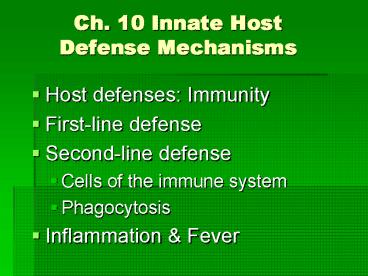Host defenses: Immunity - PowerPoint PPT Presentation
1 / 24
Title:
Host defenses: Immunity
Description:
Neutrophils, saliva, mucus, milk. Lactoferrin. Kill a variety of microorganisms ... Neutrophils. Macrophages. Produce cytokines. Interact with T helper cells ... – PowerPoint PPT presentation
Number of Views:42
Avg rating:3.0/5.0
Title: Host defenses: Immunity
1
Ch. 10 Innate Host Defense Mechanisms
- Host defenses Immunity
- First-line defense
- Second-line defense
- Cells of the immune system
- Phagocytosis
- Inflammation Fever
2
Host Defense
- Innate Immunity
- First-line defense
- Second-line defense
- Aquired Immunity
- Third-line defense
- Discussed in Ch. 11 12
3
First line defense
- Anatomical barriers
- Antimicrobial substances
- Normal flora
4
Anatomical barriers
5
Epithelial barriers
6
Antimicrobial substances
7
Normal flora
8
Second-line defense
- White Blood Cells
- Granulocytes
- Mononuclear Phagocytes
- Lymphocytes
- Phagocytosis
- Other Blood Components
- Lymphatic System
9
(No Transcript)
10
Table 15.2
11
(No Transcript)
12
Mononuclear phagocytes
Figure 15.5
13
Phagocytosis
- Neutrophils
- Macrophages
- Produce cytokines
- Interact with T helper cells activated
macrophages - Help form granulomas
- Process of phagocytosis
14
Process of phagocytosis
Figure 15.9
15
Other Blood Components
- Red Blood Cells, Platelets, Plasma
- Important role in inflammatory response
- Major function is blood clotting
- Serum
- Clear yellowish fluid that contains proteins
- Albumin
- Globulin gamma portion contains antibodies
- Complement system
- Classical pathway
- Alternate pathway
- Interferons glycoproteins
16
Figure 15.7
17
Interferons
Figure 15.11
18
Lymphatic System
- Lymphatic vessels
- 1º lymphoid organs
- Thymus
- Bone marrow
- 2º lymphoid organs
- Lymph nodes
- Adenoids
- Tonsils
- Spleen
- Appendix
- SALT
- MALT
19
Inflammation
- Initiation
- Inflammatory process
- Outcomes of inflammation
20
Initiation
- Release of chemicals
- Histamine, serotnin, kinins, and prostaglandins
- Increase in the permeability of surrounding blood
vessels - Complement cascade
- Tissue damage
21
Inflammation process
Figure 15.10
22
Inflammation process
Figure 15.10
23
Outcomes of inflammation
- Damage to surrounding tissue
- Release of bacterial endotoxins
- Eliminate invading pathogen
- Fibroblast formation
24
Fever
- Physiological response to infections
- Pyrogens
- Endogenous fever-inducing cytokines
- Exogenous bacterial endotoxins
- Hypothalamus controls temperature
- High temperature inhibits pathogen growth































